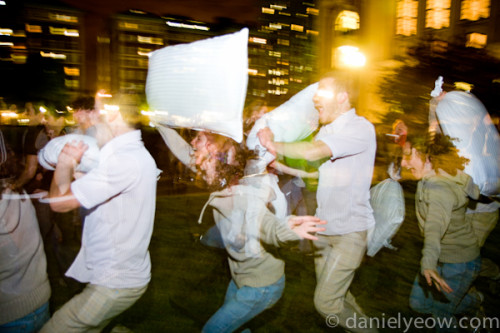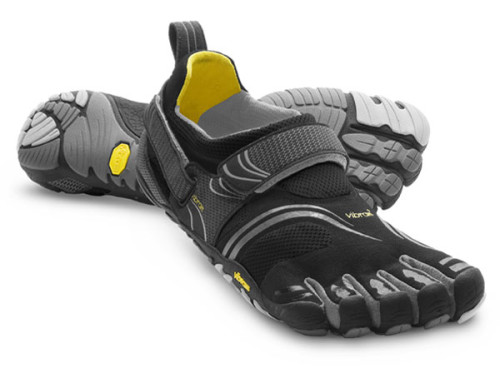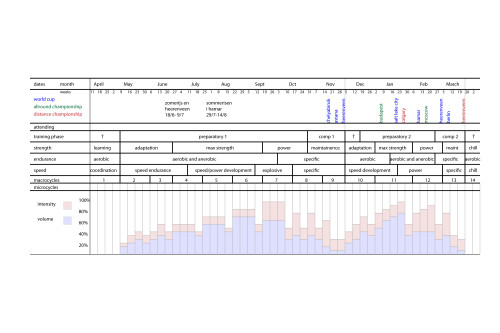Basic Training Principles
Sport is a funny thing. It is almost universally recognized that if you want to be good at a sport, then you have to train for it. However, the “how” in how people go about doing that is a source of endless amusement and frustration.
The first mistake is an easy one to make. Our minds naturally extrapolate based on our own experiences, and have this annoying tendency to extrapolate linearly. When we were kids, we learned how to play different sports. If we were particularly taken by any of those sports, we would train a little, and see almost immediate improvement. So in our minds we make that connection – more training = more improvement. It seems that many people must think that professional athletes spend all day training. We don’t.
The body needs to recover. While it is certainly true that a mature athlete, with years of training behind them, is likely to recover from any given session more quickly than an untrained athlete, there are limits to how quickly the human body can recover. In fact, at the very highest levels of sport, recovery between sessions is so important that things like ice baths, contrast showers, and compression tights have been invented for the sole purpose of speeding up recovery. Better recovery means that you can train more frequently, at a higher intensity, and at a higher quality.
Training quality is something that is often overlooked. It all comes back to this caveman-esque “more training good” mentality where people just hit everything with a hammer, and if it doesn’t work, hit it with a bigger hammer. In every sport I can think of, coordination is important, and following from that, so is proper technique. Yet many people neglect those aspects entirely from their training programs. At the lower levels of sport, it is easier to neglect those things, because you can always compensate by being stronger/fitter, but at the highest levels, where mere hundredths of a second can mean the difference between Olympic gold and silver, you need to get every little bit you can out of an athlete.
Fads and Fashion
What I also find interesting (and slightly alarming) are the many “fads” that grip the training world. Caveman diets, and shoes that basically look like thick rubber toe-socks. What is genuinely alarming is the fanaticism with which these fads are followed. It’s funny now, but when someone straps a bomb to themselves in a crowded place, then fanatical, blind, irrational, unquestioning dedication becomes far less humorous. I know that there are many more, but I’m just going to dispel the two examples I named above for now.
Caveman diets – raw foods, but often very specifically laid-out meals of raw foods. The diet is supposed to resemble the diets of early humans, particularly of the paleolithic era (it is sometimes called the paleolithic diet). The reasoning for this is that humans evolved to eat this diet, and since agriculture is a relatively recent invention (about 10,000 years old), human evolution hasn’t caught up. This is nonsense on many levels of course, but it is sometimes difficult to tell that to people. Firstly, people of the paleolithic era weren’t a whole lot more healthy than we were, and they certainly didn’t live as long. Secondly, these diets generally aren’t an accurate reflection of what people of the paleolithic era actually ate. If that were the case, then come meal time the consumer should roll a dice, and if they roll a 2 or a 5, then they can eat their meal, otherwise tough luck. Thirdly, the nutritional demands of an athlete in training are quite different (to put it mildly) to that of a paleolithic hunter-gatherer.
Shoes that look like toe socks. Strangely enough, the thinking that has allowed this footwear to enter runners gear-drawers is similar to that of caveman diets. The shoes were originally developed for yacht racers to maintain grip on a wet deck while maintaining the barefoot feel. The idea of using it as a running shoe may also have had roots in the Nike Free shoe idea. Of course, that shoe was developed to simulate the feel of barefoot running on grass, with limited success. This shoe does away with the padding altogether, and simulates barefoot running on… hard asphalt or concrete. Herein lies the logical failure – human feet were designed to run barefoot, but not on hard surfaces. The Nike Free idea came out of a Stanford U track coach who used to spend a lot of time with his athletes running barefoot on grass, which is actually quite a good idea for injury prevention. The Nike Free shoe doesn’t feel a lot like running barefoot on grass, but the basic principle is sound. These shoes… all I can say is that if you want to run in them, try to run on soft surfaces.
Curiously enough, in trying (and failing) to make a good running shoe, both of these attempts have succeeded in making a very comfortable shoe for just loafing around.
The point that most of these fads miss (and indeed many “new age” fads) is that simulating caveman conditions in a quest to be more “natural” might sound like a nice idea, but there is a good reason we don’t live in caves anymore. We live much longer, healthier (well, in some parts of the world anyway) lives with extremely different nutritional demands than even a hundred years ago, let alone 10,000. If you want to talk about sport, especially at high levels, nothing we do now resembles what our ancestors did 10,000 years ago. They didn’t run on synthetic rubber tracks with spikes on their feet. They didn’t skate in climate-controlled, perfectly smooth ice covered indoor skating tracks with custom-made carbon fiber boots on their feet. Perhaps the javelin throw is the only remnant of those ancient times (but have you ever stopped to look at a throwing shoe? did you even know that there are special shoes for throwing?)
Basics
If I had to sum up training principles into one sentence it would be – “Training is all about adaptation”. You have this body, and you’re trying to make it do certain things. You’re also often trying to make it do those things faster, stronger, or more precisely. Our bodies are very versatile, and they are also very adaptable. Whenever you go out training, you’re basically out there to kick its ass. The harder you can kick its ass, the stronger it will come back, better-adapted for that particular kind of ass-kicking.
Be specific. A lot of skaters get caught up doing lots of miles on the bike, or spending a lot of time in the gym lifting weights. That’s all well and good, but the most specific exercise for skating is skating. Since speed skating, in particular on ice, is such a technical sport, and the coordination requirements are so intense, a lot (indeed most) of the training load will take place off-skates (being too fatigued is detrimental to coordination, and that can have negative impacts on technique). Even so, exercises should be found which closely simulate the main sport in some way, either in duration, intensity, or similarity of movement.
Eat well. This might seem very obvious, but a lot of people I’ve coached don’t do it, so I feel that I need to repeat it a lot. The mantra of “rubbish in, rubbish out” applies here. Stay away from processed foods (basically junk) because they have a lower nutritional content for the amount of food you’re eating, and also because you’re taxing your metabolic system by making it digest stuff that it isn’t getting anything out of. Always eat something immediately after training – in particular within the first 20 minutes of finishing, because that’s when your body absorbs food better. Always try to include some protein in your post-workout snack, especially if you’ve just done weights. When you lift weights, you’re actually putting small tears in your muscle fibers which your body then repairs, making your muscles stronger. Eating protein helps your body do this more quickly – it helps you adapt.
Rest well. Naps can sometimes mess with your circadian rhythm, but athletes often need more than 8 hours of sleep every 24. In addition to sleeping well, you should try to fit in some “active” recovery. Short, easy bike rides, or some time in a swimming pool can actually speed up recovery. The idea is to be active enough to give your joints a shake up, and get the circulation going, but not go hard enough to tire you out. We used to do hour-long recovery rides almost every day during the summer. Granted it takes a nontrivial amount of time to build up a person’s training tolerance to the point where a daily hour-long bike ride can be considered “recovery”, despite adding 5-6 hours to our weekly training load, it actually allowed us to train more, and make that training of a higher quality.
Longer-Term
You should have a goal. I mentioned before that people who train for “general fitness” baffle me, and that’s probably because it is difficult for them to answer the question “has your training been successful?”. A specific goal, like a medal at a national or world championship race, throwing an implement a few meters further than you did last year, or even taking a few seconds off a time for your favourite distance, can help focus your training. You should always have a plan to reach that goal.
But what kind of plan will work best? Most people follow what’s called a “flat training paradigm” which is just a fancy way of saying that they do mostly the same training all year, might train a little less leading up to a competition, and that’s it. Unfortunately this kind of training happens a lot, and mostly because it’s the first proper training that most people are exposed to. They’re exposed to it as children, or teenagers, and they see steady improvement so it gets stuck in their head that it works. Of course, the real reason that young athletes see steady improvement is because they’re growing and maturing. A flat training paradigm will generally only result in very slow improvement and frustrating plateaus for mature athletes.
The truth is… or more correctly, current sports science strongly indicates that the truth is close to… that a training plan should be like a fractal. The overall shape should resemble:
The concept is simple enough. Increase the training load in steps, then decrease it. The “rest” part of the cycle is to allow your body to recuperate. Like I said before, you kick your body’s ass, then let it recover. If you start kicking its ass before you’re fully recovered, it’s going to feel it more, so you do this for a short while, but then let it recover. That way, by the end of the day, you’ve kicked your body’s ass harder than you would have if you’d simply let it recover completely between each ass-kicking.
Your annual plan should look like this from a distance. When you zoom in, the individual training phases (general preparation, specific preparation, competitive, etc) should look like this with the rest cycles coming just before important competitions. Zooming in even further, individual macrocycles (typically a month long) should look like this, and zooming riiiight in, individual microcycles should look a bit like this. At that level of detail though, the training often is dictated more by weekly scheduling, and optimum use of facilities rather than the shape above.
As you can see, a full-blown annual plan resembles the general shape of what I described above. Of course, other considerations, such as the scheduling of competitions, and the availability of facilities (like summer ice) have to be taken into consideration.
How far should the fractal concept of the step-training paradigm go? It’s hard to say. There is some evidence that athletes who slowly increase their loads over the years, then have a slightly easier year tend to do better at the end of that year, but controlled experiments over such long time spans are difficult to conduct.
A careful examination of the annual plan shows that there is a lot more at work than simply training load. Different kinds of training should be applied at different times of the year to ensure optimal results at the important competitions. In weight training alone, whole months should be dedicated to muscle hypertrophy (making muscles bigger) and coordination (making muscles smarter) before you even start to think about all that specificity stuff that I mentioned before.
The other major thing that I should probably mention is the difference between volume and intensity. To put it simply, it is the difference between squatting the bar (20kg) 10 times, and squatting 100kg twice. More volume, less intensity at the start of the year, and less volume, more intensity towards the end of the year. Your peak intensity should be tied to the peak intensity that you’re likely to experience in whatever it is you’re training for. If you’re a marathon runner, then you probably don’t need to worry about achieving a high peak intensity too much, but if you’re a 100m sprinter, then you’re whole training program is pretty much built around maximizing that peak.
Final Thoughts
So those are the “basics”. Training methodology will vary enormously from sport to sport, but those basic elements should still be there. If possible, try to “measure” as much as you can. Be it times, weights lifted, kms run, distances thrown, and keep a diary. That way you can monitor your progress, measure your fatigue, and generally know where you’re “at”, which is a useful starting point to get to where you’re going.
Balance. Not much is said in many cultures about achieving a good work life balance, even though it is essential for getting the most out of both work and life. Sport is no different – obsession is fine, and you’ll find that most elite athletes have obsessive behavioural traits, but don’t let it take over your life. There’s more to life than sport, and realizing that can often give you the perspective you need to become a better sportsperson. Humans are social beings, many of us have interests outside of sport, and allowing an obsession with sport to dominate our lives at the expense of all the rest, can actually be quite detrimental to sports performance. It really does help to be happy, which brings me to my next point:
Psychology… I haven’t written much about this because the approach to everybody is very different. As a general rule, you should try to be positive about things. That’s one of the nice things about sport, is that you have good days and you have bad days, but you can always take something good away from the experience. Everyone should psychoanalyze themselves. Find out what motivates you, and use that to focus your training. Try to train with a group wherever possible – humans are social beings, and besides, you’ll train better in a group than on your own. If you have any say in the matter, try to train with a group of people you actually like. When you’re a professional athlete, the quality of the training group, and how well you get along with them makes a HUGE difference, for no other reason than because you spend so much time with them.
Have fun. You should enjoy your sport, and that pleasure should be a motivating factor in your training. It doesn’t matter if you’re training for your local club’s curling championships, or to speed skate at the Olympic Games, you should try to enjoy the experience. That doesn’t mean you shouldn’t take it seriously, but training seriously and having fun don’t have to be mutually exclusive. Training effectively almost requires that there be fun at some level. Whether you dedicate your life to a sporting goal, or whether your goal is to be sporty for life, you should have fun while doing it, because at the end of the day it’s more rewarding to be a good sport, than to be good at sport.





No I didn’t know that there were special javelin throwing shoes. But I am not surprised.
The paranthetical phrase “being too fatigued is detrimental to coordination, and that can have negative impacts on technique” in particular caught my attention. At the moment I am interested in how to improve performance when fatigued. It wouldn’t surprise me if the only good answer is to improve fitness. I can see how to improve my physical fitness base to the point where I can run out a football game playing in the midfield. But guarding against the metal fatigue that can come after a couple of hours at the pool table or diplomacy board or chess board is not something that is as clear to approach.
So perhaps I’m just fishing for a useful response.
I heard one interesting idea, namely when practicing set shots for goal, don’t just practise the set shot (but of course do this for technique reasons), but also practise taking a set shot after doing a (say) 100m sprint, since it more closely resembles match conditions.
Not sure how effective that is. Data is hard to come by (someone has to record it!), especially once you get away from sports that score in a track and field type manner – where you receive a time or distance at each attempt (and the statiscial fluctuation is not too small – compare with cricket where it is easy to keep track of how many runs you’ve scored, but harder to discern improvements).
I like your idea about practicing set shots after doing a short sprint to simulate game conditions. I’m not sure if I’ve mentioned it here, but I say it a lot – specificity is key.
So mechanism-wise, what is actually happening in your muscles is that to do a certain movement, your individual muscles contract in a certain order and in a certain way. For more technical sports these movements can be very complicated, and difficult to simulate in training when you’re doing anything other than the sport itself. When you get tired, and lactic acid starts building up, and you start to run out of glycogen, the chemicals in your muscles “confuse” the nerves and they have the tendency to all want to contract at the same time. Numerous studies have shown that lactic acid fatigue doesn’t actually make your muscles weaker (even though it feels like it), but it makes your muscles less coordinated. (it’s like trying to play the piano with your hands inside socks)
overcoming this in your case would probably involve a two-pronged approach. First, as you say, you would work on your physical fitness. The other thing you could do, and this is difficult, is to specifically target the stabilizing muscles in your training. I don’t know much about football, but I’m assuming that the greatest comparative advantages to be had in the midfield revolve around vision, creativity, and sensing the flow of the game. Obviously, being fast, fit, and explosive are huge advantages, but spending time on concentration and coordination would likely yield significant returns.
have you heard of chess boxing? I’m kidding of course, but you could try constructing exercises for yourself which aren’t *very* physically taxing, but would quickly exhaust your concentration, and those small stabilizing muscles. Surprisingly enough, I don’t know a lot about the biomechanics involved in the kind of short sprints and frequent direction changes which happen in team sports, but maybe you could set some cones up where you have to zigzag through, then bounce-juggle some tennis balls against a wall.
Also maybe try to build up your core stability (I wrote a post on core workouts a while back). I’ve found in skating that having a strong core allows me to last longer (and skate faster) because it gives me a more stable base to push off. Maybe try working on your core strength, and flexibility. Everything that attaches to your hips, so your glutes, IT band, adductors below your hips, and all of your abs and back muscles above your hips.
as for overall fitness, try to target your anaerobic lactic system, because that’s the one that really makes you feel dizzy when it’s exhausted. fartlek-style training should also be good for the kinds of physical demands you get in a game. maybe get someone to throw you a ball, and you have to kick it back every lap or so…?
I hope you can find something useful in my rambly response.